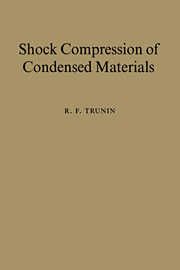8 - Liquids
Published online by Cambridge University Press: 03 December 2009
Summary
Since the number of liquids is practically unlimited, and they should be classified into numerous groups, which are often homologous series, include various solutions, mixtures, etc., it is impossible to study their properties individually. It is advisable to study representatives of various groups and extrapolate the measurements to other liquids of each group. A priori it was clear that many groups of liquids should behave similarly, and their properties would be described by similar Hugoniots. On the other hand, it was natural to admit that some liquids might have individual features and should be studied in dedicated experiments. A massive effort to study properties of liquids has been undertaken in the past ten to fifteen years, although on a lesser scale than the research on solids. Nonetheless, dozens of different liquids have been investigated, and some common features can be derived from these results.
Naturally, attention was primarily focused on water, which is the most abundant and important liquid on the Earth. The first measurements of its compression date back to 1957–58 [119, 120]. Measurements of its parameters were repeated with the aim of refining the results and extending the range of measured parameters of water under shock compression [8, 17, 28, 46, 47, 72].
The other groups of liquids subjected to shock compression were:
– saturated aqueous solutions of salts–halides, sulphates, and thiosulphates [121];
– organic liquids [28, 46, 47, 115, 122, 123];
– saturated hydrocarbons (alkanes) CnH2n+2 (n = 6, 7, 10, 13, 14, 16);
– nonsaturated hydrocarbons of the ethylene series (alkenes) CnH2n (n=6–8) and of the acetylene series (alkynes) CnH2n−2 (n=6, 8);
– aromatic hydrocarbons, namely, benzene and its derivatives, such as toluene, nitrobenzene, aniline, and styrene;
[…]
- Type
- Chapter
- Information
- Shock Compression of Condensed Materials , pp. 142 - 153Publisher: Cambridge University PressPrint publication year: 1998

